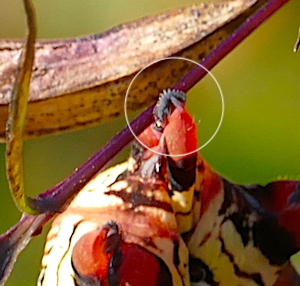Top Photo: Banded sphinx moth caterpillar barely hanging on.
Following the night of our first frost of the season I ventured out to the Floating Walkway in our wetlands to see if I could find a banded sphinx moth caterpillar that had been seen the day before. I was interested in learning about their behavior in regard to pupation, where, when and how they go about that process.

The caterpillar was still there. It was, however, only hanging on by the crochets of one proleg.


The caterpillar was folded over backwards. I assumed it was dead. It showed no movement and the temps had been, and still were, in the 20s. It should have been gone. The caterpillar should have either crawled off to pupate or expired, one way or the other, gone.

By the way, we’ve seen over a dozen banded sphinx caterpillars this past summer and fall, all feeding on primrose-willow (Ludwigia decurrens). The plants are rooted in floating planters and surrounded by water (wherever primrose-willow grows its either in or next to water).
Banded sphinx moth caterpillars pupate in soil. How do they get to soil from the plants where they spend their caterpillar days, on plants knee-deep in water? We, myself and other rangers and museum guests, have sometimes pondered that question this past season. Do the caterpillars crawl down off the plant and “walk” up the floating walkway to dry land? Do they fall into the water and hope for the best, likely drowning or eaten by some predator?

While searching for the answer to those questions and more I discovered a website devoted to the study of sphinx moths. Here’s a quote from the site concerning banded sphinx moths.
“…final instars of this species have been spotted swimming to shore from plants that are just barely above water…”
Hmmm.
I also found a couple of photos of one of the sphinx moth caterpillars actually in the water. But, I still have questions. Have they evolved to swim? is swimming part of the moth’s genetic makeup?
Most creatures that fall into water quickly learn to swim, if not already familiar with the activity, or they drown. But has this specific moth evolved to prefer plants that grow in water, their caterpillars becoming particularly adept at swimming? The ones who make it to shore get to pass on their swimming gene to later generations.
As mentioned, I’ve discovered at least two web sites which have photos of the larvae in the water, apparently swimming.
Caterpillar in water – 1 – Click and scroll down
The photos tend to raise more questions than they answer, which is fine with me. The more mysteries, the better.